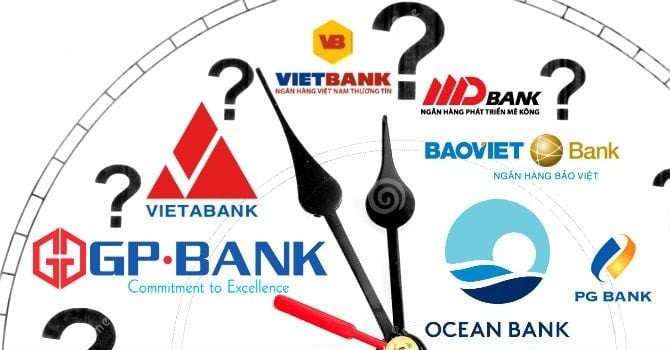Investing in technology creates superior utilities, an important factor for banks to compete and develop in the current context. However, there are still many banks that are "slow" in the technology race, facing the risk of falling behind and losing their competitive advantage.
Technology has become a decisive factor in the race between banks.
In the digital age, technology is becoming a decisive factor for the survival and development of banks. Banks with strong digital transformation will create growth opportunities and improve customer experience. However, not all banks are quick to catch up with this trend.
Currently, the Vietnamese financial market is witnessing a strong digital revolution, where technology becomes a vital factor to attract customers and optimize operations. From online account opening (eKYC) to embedded financial services, domestic banks are accelerating, making the banking experience faster and more convenient than ever.

(illustrative photo)
The Big 4 group (Vietcombank, VietinBank, BIDV, Agribank ) and the dynamic private sector (VPBank, Techcombank, VIB, HDBank, ...) have invested heavily in technology.
First of all, eKYC is a feature that allows customers to open a bank account in just a few minutes via a mobile app, without having to go to a branch. This is an important touch point that attracts millions of new customers, especially young people.
Along with that is the development of mobile banking with countless features from money transfer, bill payment, savings, online loans, to personal finance management. These banks are constantly updating, adding utilities, applying AI and Big Data to personalize services, bringing optimal experience to users.
Not stopping there, they also actively cooperate with fintechs, apply blockchain technology in international payments, and develop advanced security solutions such as biometric authentication (face recognition, fingerprints) according to new regulations of the State Bank.
While some banks are still slow to adopt technology, many others have begun to implement strong digital transformation strategies. Techcombank, Vietcombank, VPBank, BIDV are typical examples of digital banks. These banks not only upgrade their information technology systems, but also offer digital products and services, helping customers to conduct transactions quickly and securely remotely.
Accordingly, it is clear that the application of technology has become a core strategy, helping domestic banks expand market share, reduce operating costs and improve competitiveness.
Many banks are still "slow"
In contrast to the dynamism of domestic banks and some pioneering foreign banks, not all banks are quick to catch up with this trend. There are still many banks that are “slow” in the technology race, facing the risk of falling behind and losing their competitive advantage.

For example, at UOB Bank, although the UOB TMRW application has an online account opening feature, it is only applicable to customers residing in Hanoi or Ho Chi Minh City. Similarly, the Indovina Bank (IVB) application shows instability. When experiencing online account opening, the application is constantly suddenly exited, which negatively affects the user experience.
Citibank does not currently support account opening for completely new customers through eKYC. Users can only open an account if they already have a relationship with the bank (e.g., own a debit/credit card). Similarly, at HSBC, although there is an online application process for the salary package, it still requires significant human intervention. This process is not yet fully automated like domestic banks.
At Standard Chartered Bank, the form of opening an online account using eKYC has not been implemented for new customers. The SC Mobile application currently only supports registration for customers who already have an account or card with the bank, requiring the provision of existing account/card information to activate the service.
At Public Bank, customers also cannot open an account online at home, showing that the bank has not fully deployed eKYC services for new individual customers.
The slowness of some foreign banks and joint ventures in digital transformation stems from the main barriers: compliance with dual regulations (both Vietnamese regulations and parent corporation standards), market priority strategy (not focusing on ordinary individual customers) and complex technology infrastructure.
Some banks are still using old systems that are not compatible with modern technology applications. Upgrading information technology systems requires significant financial resources and time, making many banks hesitant to invest.
Lack of skilled human resources, while technology in the banking industry requires a team of experts with deep knowledge of data, artificial intelligence (AI), blockchain, and other new technologies. This shortage of human resources prevents some banks from quickly developing technological solutions.
In addition, there is no or lack of a clear and long-term technology development strategy. They may have implemented some small initiatives, but there is no comprehensive plan to integrate technology into every aspect of banking operations.
This delay poses many challenges, putting them at risk of missing out on a large number of potential customers, especially young, tech-savvy people. This not only affects market share but also undermines business efficiency and scalability in the long term.
“Late” banks will need to make a concerted effort to change in a short time to avoid being left behind. They need to invest heavily in technology infrastructure, train human resources, and build a clear and consistent technology strategy. Banks need to learn from the successes of pioneering banks and build close relationships with technology companies to optimize processes and services.
Focus on applying artificial intelligence in consulting and analyzing customer data, implementing digital banking services, e-wallets, and online money transfers. In addition, applying blockchain to secure transactions and enhance transparency will be an important factor in building customer trust.
The technology race is becoming increasingly fierce. Banks with appropriate strategies and decisive actions will not only survive but also thrive in the modern financial market and vice versa./.
Source: https://baolamdong.vn/ngan-hang-cham-chan-o-cuoc-dua-cong-nghe-nguy-co-tut-lai-phia-sau-va-mat-di-loi-the-canh-tranh-382523.html




















































![[Maritime News] More than 80% of global container shipping capacity is in the hands of MSC and major shipping alliances](https://vphoto.vietnam.vn/thumb/402x226/vietnam/resource/IMAGE/2025/7/16/6b4d586c984b4cbf8c5680352b9eaeb0)













































Comment (0)